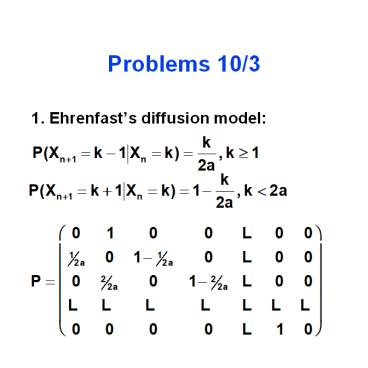Problems 10/3 PowerPoint PPT Presentation
Title: Problems 10/3
1
Problems 10/3
- 1. Ehrenfasts diffusion model
2
Problems, cont.
- 2.
- Discrete uniform on 0,...,n
3
Problems, cont.
- 3.
- where
- k0?
4
Classification of states
- A state i for a Markov chain Xk is called
persistent if - and transient otherwise.
- Let
- and .
- j is persistent iff fjj1.
- Let
5
Some results
- Theorem
- Pii(s)1Fii(s)Pii(s)
- Pij(s)Fij(s)Pij(s) for i ? j.
- Proof
- As for the random walk case we deduce from the
Markov property that - Multiply both sides by sm, sum over m1 to get
6
Some results, cont.
- Corollary
- State j is persistent if and then
for all i. - State j is transient if and
then for all i. - Proof
- SInce we see that
- But (by Abels thm)
7
A final consequence
- If i is transient, then
- Why?
- Example Branching process
- What states are persistent? Transient?
- State 0 is called absorbing, since once the
process reaches 0, it never leaves again.
8
Mean recurrence time
- Let Ti minngt0 Xn i and ?i E(TiX0i).
- For a transient state ?i 8.
- For a persistent state
- We call a recurrent state positive persistent if
?i lt 8, null persistent otherwise. - Example Simple random walk
- positive recurrent non-null persistent
9
A model forradiation damage
- Initial damage from radiation can either heal or
get worse until it is visible. - 0 is a healthy organism (absorbing)
- 3 visible damage (absorbing)
- 1 initial damage
- 2 amplified damage
10
Radiation damage, cont.
- Recovery probability ?0 is probability of
reaching 0 before 3. - Last step must go
- Thus
11
Communication
- Two states i and j communicate, , if
for some m. - i and j intercommunicate, , if
and . - Theorem is an equivalence relation.
- What do we need to prove?
12
Equivalence classes of states
- Theorem If then
- i is transient iff j is transient
- i is persistent iff j is persistent
- Proof of (a) Since there are m,n with
- By Chapman-Kolmogorov
- so summing over r we get
13
Closed and irreducible sets
- A set C of states is closed if pij0 for all i in
C, j not in C - C is irreducible if for all i,j in C.
- Theorem
- STC1C2...
- where T are all transient, and the Ci are
irreducible disjoint closed sets of persistent
states - Note The Ci are the equivalence classes for
14
Example
- S0,1,2,3,4,5
- 0,1,4,5 closed irreducible persistent
- 2,3 transient. Why?
15
Long-term behavior
- Recall from the 0-1 process that
- When does this not depend on n?
- p01 p11
16
Stationary distribution
- Case (b) is the general one. Here is the idea
Recall that ?(n) ?(0)Pn. In order to get the
same distribution for all n, we use ?(0)??where
??solves ??P ?? - ?(1) ??P ?
- ??P2 ??P ?
- ...
- ??Pn ?
17
Snoqualmie Falls
- so
- or

